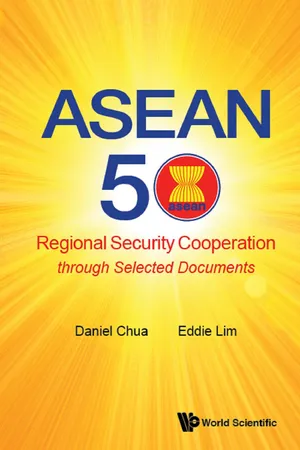
Asean 50: Regional Security Cooperation Through Selected Documents
Regional Security Cooperation through Selected Documents
- 364 pages
- English
- ePUB (mobile friendly)
- Available on iOS & Android
Asean 50: Regional Security Cooperation Through Selected Documents
Regional Security Cooperation through Selected Documents
About this book
-->
ASEAN 50: Regional Security Cooperation through Selected Documents curates key official documents that establish ASEAN as the foundation of Southeast Asia's peace and security. Since 1967, ASEAN has played the crucial role of managing conflicts and maintaining stability in a region shaped by diverse political, economic and socio-cultural dynamics. During the Cold War, ASEAN's ability to keep major power rivalries and intra-mural disputes in check provided the conditions for economic growth in the region. Yet the extent of ASEAN's contributions to the security of Southeast Asia have not been systematically presented.
This compendium of official ASEAN declarations, statements, treaties, conventions and workplans demonstrates the activism and innovation of ASEAN member countries in their management of regional security for the past five decades. ASEAN 50: Regional Security Cooperation through Selected Documents provides answers to how ASEAN remains a cohesive organisation through periods of regional conflict, how ASEAN unity thrives despite seemingly insurmountable differences among the ten members, and how ASEAN centrality is resilient against pressure arising from great power influences in Southeast Asia.
--> Contents:
- Preface
- Foreword
- Introduction
- The Formation of a Southeast Asian Association
- ZOPFAN, ASEAN Concord, and the Treaty of Amity and Cooperation
- ASEAN and the Vietnam-Cambodia Conflict
- After the Cold War: ASEAN Expansion and Engagement with Dialogue Partners
- The ASEAN Charter
- ASEAN Regional Forum and the Defence Ministers' Meetings
- ASEAN, China, and the South China Sea
- ASEAN and Non-Traditional Security
- Closing Thoughts
- Selected Abbreviations
- Selected Bibliography
- About the Authors
- Index
-->
--> Readership: University and graduate level students and professionals specialising in ASEAN. -->
Keywords:ASEAN;Security;Political Security;Southeast Asia;ASEAN Economic Community;Cold War;Political ScienceReview: Key Features:
- This book is the first major attempt at compiling primary sources for research about ASEAN's development as a security community. A previous version of the project by Eddie Lim and Ang Cheng Guan includes documents from 1967 to 1999 but remains unpublished
- The book provides students and researchers with access to the most critical documents to commence their study on ASEAN's role in Southeast Asian security. A list of suggested further readings will guide readers to other secondary sources
- This book has the potential to be prescribed reading for students and scholars working on ASEAN and Southeast Asia, diplomats and foreign service officers, and general readers
Frequently asked questions
- Essential is ideal for learners and professionals who enjoy exploring a wide range of subjects. Access the Essential Library with 800,000+ trusted titles and best-sellers across business, personal growth, and the humanities. Includes unlimited reading time and Standard Read Aloud voice.
- Complete: Perfect for advanced learners and researchers needing full, unrestricted access. Unlock 1.4M+ books across hundreds of subjects, including academic and specialized titles. The Complete Plan also includes advanced features like Premium Read Aloud and Research Assistant.
Please note we cannot support devices running on iOS 13 and Android 7 or earlier. Learn more about using the app.
Information
CHAPTER ONE
The Formation of a Southeast Asian Association
The Formation of ASEAN
Table of contents
- Cover
- Halftitle
- Title
- Copyright
- Contents
- Preface
- Foreword
- Introduction
- Chapter One: The Formation of a Southeast Asian Association
- Chapter Two: ZOPFAN, ASEAN Concord, and the Treaty of Amity and Cooperation
- Chapter Three: ASEAN and the Vietnam-Cambodia Conflict
- Chapter Four: After the Cold War: ASEAN Expansion and Engagement with Dialogue Partners
- Chapter Five: The ASEAN Charter
- Chapter Six: ASEAN Regional Forum and the Defence Ministers’ Meetings
- Chapter Seven: ASEAN, China, and the South China Sea
- Chapter Eight: ASEAN and Non-Traditional Security
- Closing Thoughts
- Selected Abbreviations
- Selected Bibliography
- About the Authors
- Index